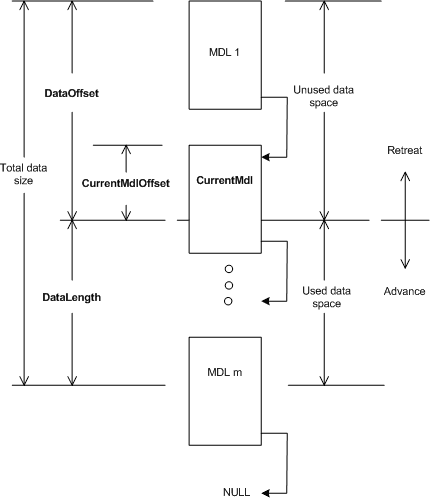NET_BUFFER Structure
NDIS 6.0 and later NET_BUFFER structures are analogous to the NDIS_PACKET structures used by NDIS 5.x and earlier drivers. Each NET_BUFFER structure packages a packet of network data.
The following figure shows the fields in a NET_BUFFER structure.

The NET_BUFFER structure includes a NET_BUFFER_HEADER structure in the NetBufferHeader member. The NET_BUFFER_HEADER structure includes a NET_BUFFER_DATA structure in the NetBufferData member. You should use NDIS macros to access NET_BUFFER structure members. For a complete list of these macros, see the NET_BUFFER structure reference page.
Some of the NET_BUFFER structure members are only used by NDIS. The members that drivers typically use are:
ProtocolReserved
Reserved for use by protocol drivers.
MiniportReserved
Reserved for use by miniport drivers.
NdisPoolHandle
Specifies a pool handle that identifies the NET_BUFFER pool from which the NET_BUFFER structure was allocated.
Next
Specifies a pointer to the next NET_BUFFER structure in a linked list of NET_BUFFER structures. If this is the last NET_BUFFER structure in the list, this member is NULL.
DataLength
Specifies the length in bytes of the network data in the MDL chain.
DataOffset
Specifies the offset, in bytes, from the start of memory in the MDL chain to the start of the network data in the MDL chain.
CurrentMdl
Specifies a pointer to the first MDL that the current driver is using. This pointer provides an optimization that improves performance by skipping over any MDLs that the current driver is not using.
CurrentMdlOffset
Specifies the offset, in bytes, to the beginning of the used data space in the MDL that is specified by the CurrentMdl member of the NET_BUFFER structure.
The following figure shows the relationship between the CurrentMdl, CurrentMdlOffset, DataOffset, and DataLength members and the data space.

NDIS provides functions to manage the data space in the MDL chain. How drivers use the data space changes dynamically with the current driver. Sometimes there is data space that is currently unused by the current driver. Although the unused data space is currently unused, it can contain valid data. For example, on the receive path, the unused data space can contain header information that was used by a lower level driver.
Drivers perform retreat and advance operations to increase and decrease the used data space. For more information about retreat and advance operations, see Retreat and Advance Operations.
The following terms and definitions describe elements of the NET_BUFFER data space:
Used data space
Used data space contains data that the current driver is using at the current time. Drivers increase used data space with retreat operations and reduce used data space with advance operations.
Unused data space
The current driver is not using this data space at the current time.
Total data size
The total data size is the sum of the size of the used data space and unused data space. To calculate the total size, add the DataOffset to the DataLength .
Retreat
Retreat operations increase the size of the used data space.
Advance
Advance operations decrease the size of the used data space.
Feedback
Coming soon: Throughout 2024 we will be phasing out GitHub Issues as the feedback mechanism for content and replacing it with a new feedback system. For more information see: https://aka.ms/ContentUserFeedback.
Submit and view feedback for